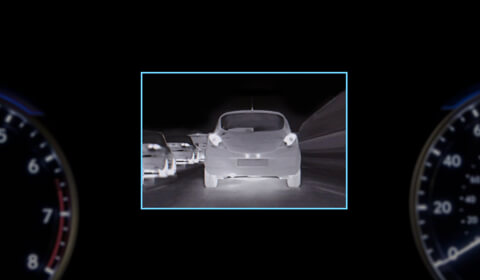What is night vision?
Car night vision is a sensor that, when activated, will help you stay aware of persons, vehicles, or animals that are out of reach of your headlights. Many of the newer automotive infrared systems are advanced to the point that their algorithms determine whether a hot spot ahead is living or moving to alert you of any possible danger.

Does my car have night vision systems?
Night vision is primarily an optional feature of some modern vehicles so check the user manual to be sure. The infrared and thermal sensors are typically mounted in the vehicle’s grille and display images in the screen in the center console or dashboard. Newer technology can project the images in a heads-up display in the windshield, showing the exact location of traffic ahead. Both of these types of systems are typically controlled by the on-board computer mounted in the center console.
How does night vision on your car help?

If conditions make it difficult to see, having night vision can be a huge asset that provides many benefits. Car night vision uses thermographic sensors to detect IR waves or heat back at the vehicle to determine the distance of objects ahead. In heavy rain and snow, knowing how much stopping distance you have makes everyone driving safer. If the road is poorly lit, the night vision will show you what is in front of your vehicle, alerting you to any obstacles sooner. The night vision not only picks up other cars on the road, but pedestrians, deer, and other creatures, helping you to avoid an accident.
Are there different types of night vision for your car?
The advancements of detection and alert night vision systems are useful for all drivers. When it comes to night vision systems for your vehicle, there are two main categories:
Active car night vision
Depending on the year and model of your car, active night vision offers a shorter range in front of your headlights, but more lifelike images of what’s ahead of you. Roads and buildings on the side of roads will show up if they’re within the IR spectrum. The range for active night vision is around 600 feet, and that could be affected depending on weather conditions.
Passive car night vision
Passive night vision doesn’t have as clear of images, but the range is extended up to 1,000 feet. Most cars that come with night vision have passive, which are more efficient by measuring heat without needing more illumination. The downside of passive vision is their unreliability in hot temperatures (over 98 degrees). These systems rely on thermographic cameras to detect thermal radiation.
Car night vision systems and replacement
Night vision sensors are mounted in different places on a vehicle, depending on the year, make, and model. If your vehicle’s night vision sensor is mounted in the windshield, you may need to check the wiring should your windshield need replacing. Let your auto glass technician know if you have windshield-mounted night vision or any other auto glass technologies, so we can replace your auto glass more efficiently, and get you back on the road.